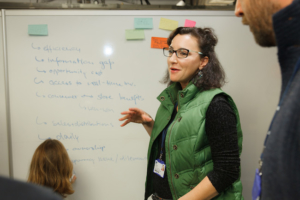Maxwell, who graduated from the program this spring with 29 others, says that interdisciplinary approach has helped him transition from his previous position in his company, as director of finance, to his current role, director of human resources. It also has made him a more effective communicator.
“Having spent the last couple of years managing groups of people, managing teams and working in teams, working with new subject matter and content, and synthesizing different concepts together to talk about business problems in a nuanced way, I think all of that contributes in some way to my performance,” he says.
FROM ALL OVER THE WORLD
IE-Brown has graduated 120 students since its 2011 launch. They come from all over the world — 30% from Europe, 40% from North and South America, 10% from Africa, and 20% from Asia Pacific — a fact that appealed greatly to Samantha McDermott when she was mulling MBA programs.

Samantha McDermott
McDermott, now a senior adviser for Strategic Business Initiatives in Orange County, California, was working as chief marketing officer for a regional law firm when a mentor suggested she needed to challenge herself. Her business experience coupled with an art/art history degree from Colgate University made her the ideal candidate for — practically the embodiment of — the IE-Brown program.
“The blend of social sciences and humanities that you get from Brown, because they are a world-class research organization, they’re not traditional — and I say traditional with air quotes because it wasn’t hard and fast out of a book,” says McDermott, 44, who graduated this spring. “It was a broader and yet deep experience, and on the IE business side the professors came from industry, some of them were still working in industry, which was really great because you saw a different perspective.”
Diversity of instruction was matched by diversity in the cohort, she says. And not just of nationalities — of background, too. Some 21% percent of the class of 2016 came from the energy sector; 17% from banking, and another 17% from telecommunications. Seven percent came from NGOs.
“They intentionally put you on very diverse teams,” McDermott says. “My last team, I had a guy from Ohio, a guy from India, a guy from Moscow, and a guy from Kenya. And I’m the only female. And I’m not a pushover. I’m very much a type-A woman, so I know that there was some learning on both sides, how to manage through some of those conversations when you don’t agree with somebody or you don’t necessarily see eye to eye.
“How do you work through those conflicts? And that’s what I’ve been told is pretty common in MBA programs, but I think it’s a different experience when you have so many different nationalities.”
TWO-WAY STREET TO SHARED EXPERIENCE
That exposure to other cultures means it’s vital to keep an open mind, McDermott says. And to be ready to change your way of thing altogether.
“Even if you think you have a real handle on what’s happening in other parts of the world — and candidly, I thought I did, because a lot of the clients who I dealt with were from other parts of the world and doing business overseas in multinationals — but having these intimate conversations with people, it does change your perspective,” she says.
It works both ways, though. “A lot of the folks I talked to said, ‘We had these preconceived notions about Americans and you guys aren’t exactly what we thought,'” McDermott says. “And I think on some level it has to do with the fact that you get people at a different level and they’re obviously seeking the same type of experience, so there’s a commonality there.”





Questions about this article? Email us or leave a comment below.